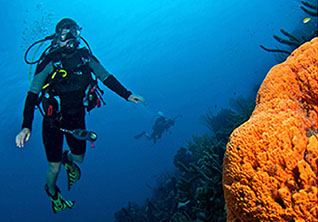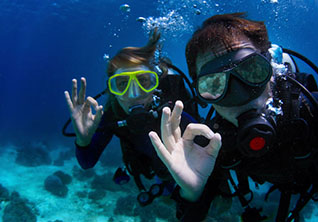GHOST PIPEFISH, PIPEFISH, SEAHORSES, AND SEA DRAGONS

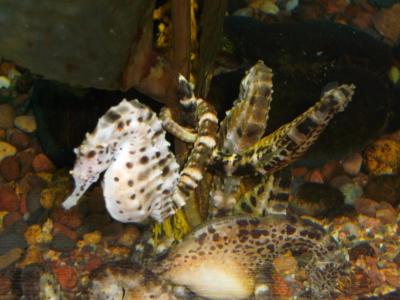
Ghost pipefish, seahorse and sea dragons are a group of small fantastically photogenic fish that are found throughout the tropical regions of the world between 45°N and 45°S latitude. Seeing these species when scuba diving makes for a great diving day. The seahorses are the group that we know the best as their head reminds us of a horse. Also, the males have a pouch in which they carry fertilized eggs which they will expel when their eggs hatch and the fry are ready to take on the world in the form of miniaturized versions of adults. Some species are extremely well camouflaged, and therefore some of the species have only been recently discovered. Choose your dive adventures by viewing there various destinations.
The Harlequin Ghost pipefish is the the best known of the ghost pipefish with its white and dark colored bands of cryptic coloration. If you can spot a Ghost Pipe fish you can see the weedy appendages that they have on the underside of their snout, but these camouflaged fish may appear as parts of crinoid, gorgonian coral, or even a piece of calcareous laden algae. They may also appear hairy or filamentous to blend in with the local seagrass. They swim slowly with their head pointed slightly downward and they are constantly ready to suck up mysid shrimp. Ghost pipefish are in a different family than the rest of the group mentioned here, as the females carry the fertilized eggs in a brood sac formed by their pelvic fins. So, with Ghost pipefish, the females have double duty as they develop eggs and brood the young.
Pipefish, Seahorses, & Sea Dragons have figured out that if they divide the embryotic chores, the more batches of offspring they can have in a year without overloading one or both of the parents. The way it works is during courtship, the ready eggs are delivered to the male. In seahorses this means eggs are placed inside the brood pouch on a male seahorse or on a brood patch on the ventral side of a male Pipefish. The males then take over the development of the embryos, while the females start working on a new batch of eggs. Not only is this work load better divided, but the male can also transmit immune information and nutritional fluids to developing eggs during the entire brooding period.
As for pipefish in general, they always have a dorsal fin present. They may move through the sea grass similar to a snake or move through the water using their caudal fin which may be small and see through or larger and brightly colored. It is thought that seahorses diverged from a common ancestor of pipefish some 23mya (million years ago). Some male pipefish have a slender enclosable brood pouch while other pipefish have a specialized brooding area where eggs adhere to the body. It should be known that it is common for the female to offer eggs to more than one male if she has extra eggs. Males on the other hand have proven to be just as unreliable mates as laboratory studies have proven that males may discard smaller eggs or absorb some of the eggs, they are brooding at the mere sight alone of a larger or more developed female.
The 47 species of seahorses on the other hand have developed elaborate rituals that not only keep most pairs bonded during a breeding interval, but also help synchronize the timing of the fully developed eggs to be inserted in the recently pumped/inflated male brood pouch. These up to 8-hour courtships usually consist of 4 phases starting with predawn dancing, pointing pumping, pointing pointing, and final copulation or transfer of eggs and insemination. Depending on the species, males may carry 5 to 2,500 eggs.
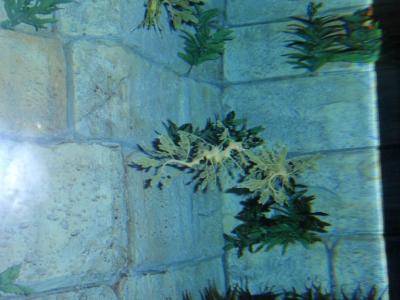
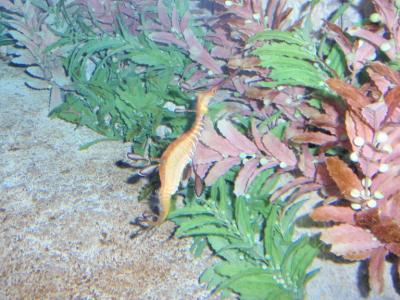
Seahorses swim slowly upright and seem to wear a crown or coronet on top of their head. Their tails are prehensile so the easiest way to feed with their rudimentary digestion system is to hold on to an object with their tail and let planktonic mysid shrimps, crabs, and of course brine shrimp by the thousands per day, float right towards them. With a quick elevation of their head, they suck in the helpless planktonic critters as fast as they can. Using their dorsal fin, they are one of the slowest fish in the world. Each species may have a specific number of bony plates (rings) that make up the internal body skeleton. Pygmy seahorses have 12 trunk rings and 26-29 tail rings.
Sea Dragons are an extremely long snouted type of seahorse that swim horizontally using their dorsal and pectoral fins (more on this in a minute). Larger specimens first appear in the fossil record 3mya (million years ago). All three species are endemic to Australia. The common sea dragon or Weedy Sea Dragon (Weedies) live along the southern Australian (Aussie) coastline, but may be seen as far north as Sydney, NSW on the east coast of Australia. They also frequent Tasmania and the southwestern Indian ocean. Weedy Sea Dragons have a few leaf-like budding appendages or lobes that may have color tones of purple and yellow. They are thus camouflaged from predators, yet look like drifting safe havens for plankton. The males may brood some 120 eggs.
Leafy Sea Dragons (Leafies) have gone overboard on the camouflage and their long leaf like appendages could either blend in with a grape tree or just about any underwater habitat. With all this camouflage foliage, they can move through the water at the breathtaking speed of 490ft per hour. You can only imagine why they seldom leave South Australia’s warm waters. Victoria, Rapid Bay, and Edinburgh are the perfect spots to encounter Leafies eating amphipods, larval fish, and mysid shrimps. Males brood some 250 eggs.
Ruby Sea Dragons (Rubies) are one of the newest discoveries of Sea Dragons. Unlike other Sea Dragons they have stump like appendages and use a prehensile tail. They have been found at depths below 150ft, where their ruby red color is absorbed by the background colors making almost invisible. Little else is known about them as they are only seen wash ashore after a bad storm or are caught in a dredging operation. The major question seems to be, did they retain their prehensile tail to remain in one deep dinning location, but augment their stumpy lobe bodies to resemble stumpy looking sponges and coral? This would make them possibly the oldest species of the three known species of Sea Dragons. Or, did they reduce their appendages and through the process of convergent evolution end up re-establishing the use of a prehensile tail?
Because all of these fish have camouflage abilities, they may be hard to see when scuba diving without the help of a local guide. Some of them, such as male seahorses, may live in a very defined area while Ghost Pipefish may wander off with the ocean’s currents until returning seasonally to shallow waters to breed. The waters of Indonesia are ripe with several species of Ghost Pipefish, while Australia has a monopoly on Sea Dragons and even Hawaii has one seahorse species that calls the islands home. Diving even in Mediterranean waters may give you a chance to see a seahorse. They seem to be ubiquitous if the waters and currents remain warm.
On the down side, they can be worth more than gold by weight by Chinese medicinal makers. These fish are also susceptible to inshore pollution by humans, and continue to be a By Catch concern. Storms may also take their toll on shallow water fish that are slow to get out of the way. However, on the bright side, breeding programs in several world class aquariums have figured out how to breed even Sea Dragons in captivity with some success. With our help, we may be able to take pictures of them well into the future. The question is, will we have to point out where the fish is in the picture, or will others finally figure out that the fish was in the middle of the frame the entire time, but just camouflaged, and therefore hidden from our view.
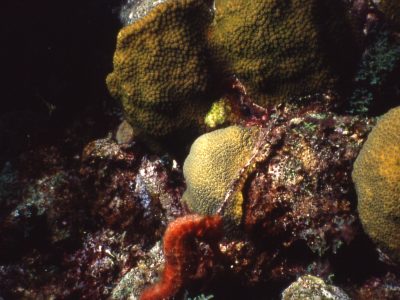
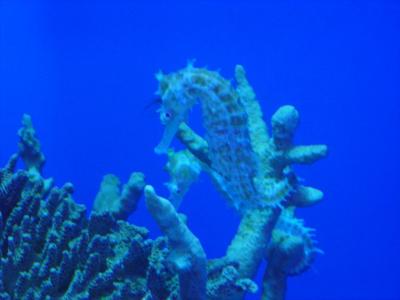

Recent Posts
- Finding the Right Dive Resort For Your Vacation
- Luxury Dive Resorts That Offer Unforgettable Experiences
- Eastern Malaysia, Sabah, Sipadan & More
- Ghost Pipefish, Pipefish, Seahorses, and Sea Dragons
- Australia Queensland and the Great Barrier Reef
- Tioman Islands, Malaysia
- The Riviera Maya
- The Peter Diving System
- The Bay Islands, Roatan, Utila, Guanaja, and more.
- The Cuttlefish; The Undisputed Master of Camouflage.
Categories
- Australia
- Bahamas
- Bay Islands
- Belize
- Blue Hole
- Bonaire Diving
- Borneo
- Cayman Brac
- Cayman Islands
- Cozumel
- Curacao
- Cuttlefish
- Dive Destinations
- Dive Equipment
- Dive Liveaboards
- Dive Resorts / Properties
- Dive Travel
- Dive Travel Deals
- Diver Wellness
- Dolphins
- Dominica
- Eagle Rays
- eagle rays
- Family Travel
- Fiji
- Galapagos Islands
- Great White Shark cage diving
- Guanaja
- Honduras
- Indonesia
- Infographics
- Isla Mujeres
- Learning to Dive
- Little Cayman
- Maduro Dive Newsletter
- Malaysia
- Maldives
- Manta Rays
- Marine Life
- Mexico
- Micronesia
- Muck Diving
- Myamar
- Palau
- Papua New Guinea
- Pelagics
- Philippines
- Pinnacles
- Polynesia
- Reefs
- Riviera Maya
- Roatan
- Saba
- Sabah
- Scuba Diving
- Scuba Gear Reviews
- Scuba News/Events
- Scuba Training & Education
- Sea Legends
- sea lions
- Sea of Cortez
- Sharks
- Single Travel
- Sipadan
- Socorro Islands
- South Africa
- Specialties
- ST. Kitts
- Stingrays
- Tahiti
- Thailand
- The Bucket List
- Tobago
- Truk Lagoon (Chuuk)
- Turks and Caicos Islands
- Turtles
- Uncategorized
- Underwater Photography
- Underwater Video
- Utila
- Walls
- Whale Sharks
- Whales
- Wreck Diving
- Wrecks
- Yap
Archives
- June 2025
- January 2024
- April 2023
- March 2020
- March 2019
- January 2019
- November 2018
- September 2018
- July 2018
- May 2018
- March 2018
- January 2018
- October 2017
- September 2017
- June 2017
- April 2017
- February 2017
- January 2017
- October 2016
- August 2016
- July 2016
- May 2016
- March 2016
- February 2016
- January 2016
- December 2015
- August 2015
- June 2015
- April 2015
- January 2015
- November 2014
- July 2014
- April 2014
- February 2014
- December 2013
- November 2013
- October 2013
- September 2013
- August 2013
- July 2013
- June 2013
- May 2013
- April 2013
- March 2013
- February 2013
- January 2013
- December 2012
- November 2012
- October 2012
- September 2012
- August 2012
- July 2012
- June 2012
- May 2012
- April 2012


